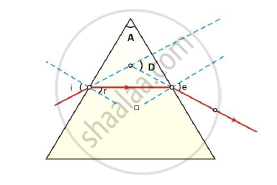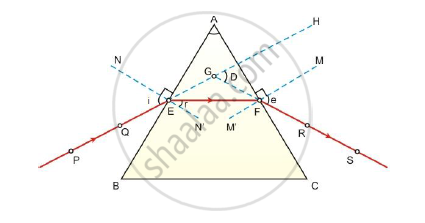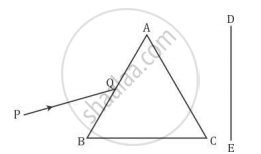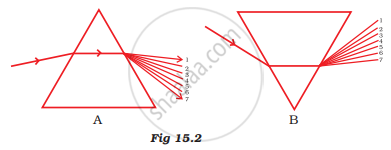Advertisements
Advertisements
Question
In the following ray diagram the correctly marked angle are:

(a) ∠i and ∠e
(b) ∠A and ∠D
(c) ∠i, ∠e and ∠D
(d) ∠r, ∠A and ∠D
Solution
(d) ∠r, ∠A and ∠D
The angle between the normal and the incident ray is the angle of incidence.
The angle between the normal and the emergent ray is the angle of emergence.
The correctly marked angles are shown in the diagram below:

APPEARS IN
RELATED QUESTIONS
A narrow beam PQ of white light is passing through a glass prism ABC as shown in the diagram.

Trace it on your answer sheet and show the path of the emergent beam as observed on the screen DE.
(i) Write the name and cause of the phenomenon observed.
(ii) Where else in nature is this phenomenon observed?
(iii) Based on this observation, state the conclusion which can be drawn about the constituents of white light.
Draw a ray diagram to show the dispersion of white light.
What will happen if another similar glass prism is placed upside down behind the first prism?
Describe how you could demonstrate that white light is composed of a number of colours.
Which of the following colour of white light is least deviated by the prism?
(a) green
(b) violet
(c) indigo
(d) yellow
You are given a disc divided into seven sectors with colours violet, indigo, blue, green, yellow, orange and red in them. What would be its colour when it is rotated rapidly?
Draw a labeled ray diagram to illustrate the dispersion of a narrow beam of white light when it passes through a glass prism.
A wave has wavelength 50Å of name the wave.
State the correct sequence (1-7) of colours in the spectrum formed by the prisms A and B, shown in Figure 15.2.

State True or False:
"Wavelength of red light is close to 700 nm.”
